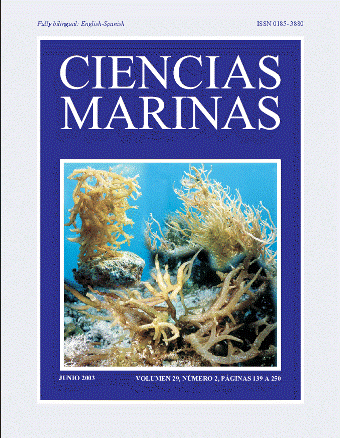Agar from two coexisting species of Gracilaria (Gracilariaceae) from the Mexican Caribbean
Main Article Content
Abstract
Gracilaria cornea and G. crassissima are similar species that coexist at Bajo Pepito in the Mexican Caribbean. Differences in agar properties from both species were determined for two reproductive categories: carposporic and undetermined, the latter mainly composed of tetrasporophytes. Agar yield (AY), agar gel strength (GS), 3,6-anhydrogalactose content (AG) and sulfate content (S) of native and alkali-treated agar were determined for both reproductive categories. Significant differences in native and alkali-treated agar between the reproductive categories were recorded for AY, GS and S from G. cornea and G. crassissima, as well as for AG of native agar from the latter species. Our results, and previous studies, demonstrate that neither reproductive stage was predominant over the other(s) in terms of having greater or lower values of agar properties. The potential economic use of agar differences from plants of different reproductive stage remains very limited. Lower AY and GS were found for G. cornea from the Caribbean side of the Yucatan peninsula (this study), in comparison to agar values reported for the Gulf of Mexico side of the peninsula. Warmer and nutrient-poorer waters on the Caribbean side could cause those differences. No pattern for GS or S was found when these two and other tropical species of Gracilariaceae were compared to temperate species. When plants of both reproductive categories were pooled together for each Gracilaria species, significant differences were found in all agar properties. Interspecific and intraspecific differences between and within species of Gracilariaceae have also been found for phenological events. We suggest that the coexistence of G. cornea and G. crassissima requires different phenological responses by each species to the environment at Bajo Pepito, which in turn could be reflected in differences in the agar properties we measured, both at the interspecific and intraspecific levels.
Downloads
Article Details
This is an open access article distributed under a Creative Commons Attribution 4.0 License, which allows you to share and adapt the work, as long as you give appropriate credit to the original author(s) and the source, provide a link to the Creative Commons license, and indicate if changes were made. Figures, tables and other elements in the article are included in the article’s CC BY 4.0 license, unless otherwise indicated. The journal title is protected by copyrights and not subject to this license. Full license deed can be viewed here.

